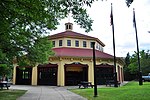Caledonia Building
1874 establishments in MassachusettsBuildings and structures in Holyoke, MassachusettsCommercial buildings completed in 1874Commercial buildings on the National Register of Historic Places in MassachusettsHistoric district contributing properties in Massachusetts ... and 2 more
NRHP infobox with nocatNational Register of Historic Places in Hampden County, Massachusetts

The Caledonia Building, also known as Caledonian Hall or The Caledonian, is a historic commercial building located at 185-193 High Street in downtown Holyoke, Massachusetts. Built in 1874, it is one of that commercial district's finest examples of Victorian architecture and a rare representative example of the development of the city's Scottish immigrant community. It was listed on the National Register of Historic Places on July 3, 1979, and was included in the North High Street Historic District on June 26, 1986.
Excerpt from the Wikipedia article Caledonia Building (License: CC BY-SA 3.0, Authors, Images).Caledonia Building
High Street, Holyoke
Geographical coordinates (GPS) Address Nearby Places Show on map
Geographical coordinates (GPS)
| Latitude | Longitude |
|---|---|
| N 42.2075 ° | E -72.6075 ° |
Address
High Street 198;200;208;210
01040 Holyoke
Massachusetts, United States
Open on Google Maps










